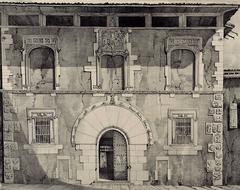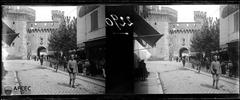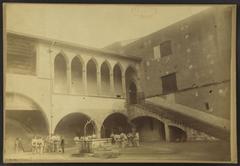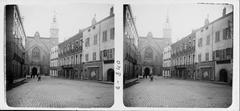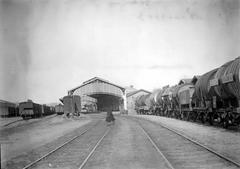Visiting Campo Santo: Hours, Tickets, and Historical Significance in Perpignan, France
Published Date: 25/07/2024
Introduction to Campo Santo
Nestled in the heart of Perpignan, France, Campo Santo, also known as the Saint-Jean Cemetery, is a treasure trove of history and Gothic architecture. Established in 1321, this ancient cemetery offers a fascinating glimpse into medieval ecclesiastical life and serves as a significant cultural hub today. Campo Santo was originally created by Bishop Guillaume de Harcourt as a burial ground for the canons of the Cathedral of Saint-Jean-Baptiste, reflecting the medieval church’s emphasis on sacred burial grounds. Renowned for its Gothic architectural style, the site is enclosed by a cloister featuring pointed arches, ribbed vaults, and flying buttresses. Over the centuries, it saw several expansions, including the addition of chapels in the 15th century funded by wealthy patrons. Despite falling into disrepair by the 18th century, the 19th-century revival of interest in medieval architecture led to comprehensive restoration efforts. Today, Campo Santo is not only a protected historical monument but also a vibrant cultural venue hosting various events such as concerts and art exhibitions. (Wikipedia, Perpignan Tourism, In France)
Contents Overview
- Introduction
- Historical Significance
- Origins and Early History
- Expansion and Modifications
- Decline and Restoration
- Architectural Significance
- Gothic Architecture
- Symbolism and Iconography
- Cultural and Religious Significance
- Notable Burials
- Cultural Events and Exhibitions
- Visitor Information
- Visiting Hours
- Tickets
- Accessibility
- Visitor Tips
- Nearby Attractions
- Cathedral of Saint-Jean-Baptiste
- Palace of the Kings of Majorca
- Local Markets
- FAQ
- Conclusion
Exploring Campo Santo - History, Visiting Hours, and Tickets in Perpignan
Introduction
Nestled in the heart of Perpignan, France, the Campo Santo (also known as the Saint-Jean Cemetery) is a treasure trove of history and Gothic architecture. This ancient cemetery, dating back to the 14th century, offers a fascinating glimpse into medieval ecclesiastical life and serves as a significant cultural hub today. In this article, we’ll explore the rich history of Campo Santo, its architectural marvels, visiting hours, ticket information, and tips for making the most of your visit.
Origins and Early History
The Campo Santo, established in 1321 by Bishop Guillaume de Harcourt, originally served as a burial ground for the canons of the Cathedral of Saint-Jean-Baptiste. This initiative was part of a broader effort to provide dignified burial spaces for clergy members, reflecting the medieval church’s emphasis on sacred burial grounds.
Architectural Significance
Renowned for its Gothic architectural style, the Campo Santo is enclosed by a cloister featuring pointed arches, ribbed vaults, and flying buttresses. This design not only provided a sheltered space for contemplation and prayer but also symbolized the heavenly paradise that awaited the faithful after death.
Expansion and Modifications
Throughout the centuries, the Campo Santo saw several expansions, including the addition of chapels in the 15th century. Wealthy patrons often funded these chapels to secure prestigious burial sites. Notably, the Chapel of Saint Michael, with its intricate stone carvings and stained glass windows, stands out.
Decline and Restoration
By the 18th century, the Campo Santo had fallen into disrepair. However, the 19th-century revival of interest in medieval architecture led to restoration efforts by the French government. These projects aimed to preserve the cemetery’s architectural integrity, including repairing the cloister and conserving stone carvings and stained glass windows.
Modern-Day Significance
Today, the Campo Santo is a protected historical monument and a popular tourist attraction. It serves as a vibrant cultural hub, hosting various events such as concerts and art exhibitions, offering visitors a unique blend of history and contemporary culture.
Notable Burials
The cemetery is the final resting place of several notable figures, including Pierre de Marca, a prominent historian and Archbishop of Paris, and François de Neufville, Duke of Villeroy, a distinguished military leader under King Louis XIV.
Cultural and Religious Significance
The Campo Santo holds significant cultural and religious importance for the people of Perpignan. Its Gothic architecture and artistic elements reflect the religious and cultural values of the time, and the serene cloister continues to be a place of reflection and spiritual solace.
Preservation Efforts
Ongoing preservation efforts involve collaboration between local authorities, historians, and conservationists. Designated as a protected historical monument, the Campo Santo receives necessary funding and resources for its upkeep, ensuring its historical significance is maintained for future generations.
Visitor Experience
Visitors can explore the cloister, chapels, and various tombs. Guided tours are available, offering in-depth information about the site’s history, architecture, and notable burials. The cemetery’s serene atmosphere provides a unique experience for those interested in medieval history and Gothic architecture. Cultural events such as concerts and art exhibitions further enhance the visitor experience.
Accessibility and Visitor Tips
The Campo Santo is located in the heart of Perpignan and is easily accessible year-round. Visitors are advised to wear comfortable walking shoes due to uneven surfaces and cobblestone paths. Photography is allowed, but visitors should be respectful of the site’s historical and cultural significance. For more information, guided tours, and brochures are available at the entrance.
Visiting Hours and Tickets
Campo Santo is open year-round with varying hours depending on the season. Tickets can be purchased at the entrance or online. For the most up-to-date visiting hours and ticket prices, check the official Campo Santo website or contact the local tourist office.
Nearby Attractions
While in Perpignan, visitors can also explore the nearby Cathedral of Saint-Jean-Baptiste, the Palace of the Kings of Majorca, and the vibrant local markets. Combining these visits offers a comprehensive understanding of Perpignan’s rich historical and cultural tapestry.
FAQ Section
Q - What are the visiting hours for Campo Santo?
A - The visiting hours vary depending on the season. It’s best to check the official Campo Santo website or contact the local tourist office for the most accurate information.
Q - How much do tickets to Campo Santo cost?
A - Ticket prices may vary. Please visit the official Campo Santo website or check at the entrance for the latest prices.
Q - Is Campo Santo accessible for people with disabilities?
A - While efforts have been made to accommodate all visitors, some areas may be challenging due to uneven surfaces and historical architecture. It’s advisable to contact the site in advance for specific accessibility information.
Q - Are guided tours available?
A - Yes, guided tours are available and provide valuable insights into the history, architecture, and notable burials at Campo Santo.
Conclusion
The Campo Santo in Perpignan offers a unique blend of history, culture, and architectural beauty. Whether you’re a history enthusiast or a casual visitor, this ancient cemetery provides a fascinating glimpse into the past. Plan your visit today and experience the serene and contemplative atmosphere of one of Perpignan’s most treasured historical sites.
Summary and Final Thoughts
Campo Santo in Perpignan stands as a remarkable testament to the region’s rich historical, architectural, and cultural heritage. From its origins as a medieval cemetery to its current status as a protected historical monument and cultural venue, Campo Santo offers visitors a unique blend of history, spirituality, and contemporary cultural experiences. Its Gothic architecture, intricate stone carvings, and serene atmosphere provide a fascinating glimpse into medieval life and death. Whether you’re a history enthusiast, an architecture aficionado, or simply seeking a peaceful retreat, Campo Santo is a must-visit destination. By planning your visit with the practical information provided, you can ensure a memorable and respectful experience at this treasured landmark. For more details on visiting Campo Santo and other historical sites in Perpignan, download the Audiala app, check out related posts, or follow us on social media for updates. (Perpignan Tourism, In France)

